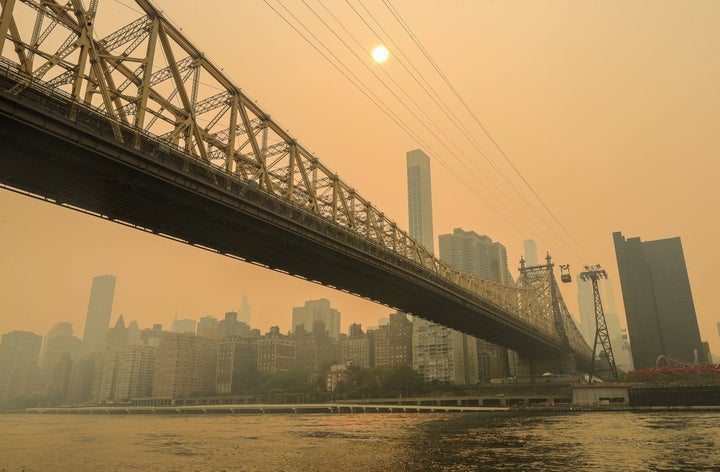As the campfire smell thickened into a smoky haze over central New Jersey this week, Kathy Jackson closed all the windows and turned on the air conditioner. If it had been one of this region’s increasingly brutal summer heat waves, she might have turned off the energy-hungry appliance once the sun went down and reopened the windows to catch a breeze.
But the wildfire smoke drifting south from Canada’s record-breaking infernos doesn’t wane when the sun sets. And getting too many of those tiny airborne particles in her airways could be deadly for Jackson, an asthmatic who suffers from severe chronic obstructive pulmonary disease.
For a senior on a fixed income, running the AC or an air purifier all day and night would be financially devastating had she not recently switched to a fixed-price utility bill.
“There was a time I was paying $1,700 in the summer,” Jackson, who is nearly 70 years old, said by phone on Wednesday afternoon. “Now, with this program, it’s substantially less. I have asthma. I also have COPD. I have it really, really bad. This fire situation –”
She trailed off and let out a wheezing cough. “We had to close all our windows and everything,” she said. “It’s scary.”
Millions of people are still paying exorbitant electricity rates as wildfires blanket broad swaths of the continent with the most toxic air they’ve experienced in nearly a quarter-century. Unlike at the height of the COVID-19 pandemic, when public health officials urged vulnerable Americans to stay inside but keep fresh air circulating, breathing easy in this latest disaster in a part of the country that hasn’t experienced wildfires comes at a steep price — and at just the moment when the cost of everything else is soaring.
The densely populated U.S. Northeast, where the smoke is pouring in from Canada, already pays electricity rates far above the national average as states like New York and Massachusetts shut down nuclear power plants and grow more dependent on natural gas, the price of which has fluctuated wildly since Russia’s invasion of Ukraine sparked a global energy crisis.
Power prices are on pace to keep climbing in the coming years as government policies to cut climate-changing pollution increase demands on the grid for electric vehicles, stovetops and heating systems — to say nothing of the spikes that come from air conditioning on days when those without it risk roasting to death.
As average global temperatures continue their steady ascent and flames engulf woodlands at scales and frequencies previously unseen in human history, the need for more artificially cleansed air is only likely to grow.
In a bid to slow the novel coronavirus’ spread, nearly every U.S. state prohibited utilities from shutting off service to households that fell behind on bills in 2020. But those bans, which never extended similar protections to many rural Americans, have now ended in most places, leaving millions with enormous debts, despite limited government relief packages.
“Low-income households are once again facing very high electricity bills,” said John Howat, a senior energy analyst at the National Consumer Law Center, a watchdog group in Boston. “For those without options other than to close the windows and perhaps switch on an air conditioner, that could create expenses that are going to be very difficult to manage. Not only during this event, but throughout the summer.”

The pandemic-era utility bills are coming due as governments end policies barring landlords from evicting renters, along with the federal tax credit that briefly slashed the number of American children in poverty by 40%, the pause in student debt payments and the extra food stamp benefits that kept millions fed. As that economic relief fades, inflation spurred by corporate price-gouging, COVID-19 supply crunches and chaotic energy prices has kept the cost of living stubbornly higher than before those benefits took effect.
This latest squeeze illustrates how the United States’ haphazard transition away from coal, oil and gas exacts the heaviest toll on the very people who have already borne the worst of fossil fuels’ pollution and price fluctuations.
Two-thirds of the U.S. faces potential blackouts and electricity shortages this summer as the aging grid heaves amid massive changes in demand and supply, and New York City is at particular risk, the North American Electric Reliability Corporation, a watchdog group, warned in its most recent forecast.
Researchers routinely record far higher rates of asthma, cancer and other respiratory illnesses in working-class neighborhoods abutting fossil fuel plants and highways.
In Astoria, Queens, an immigrant enclave that also houses New York City’s largest oil- and gas-burning power stations, lifelong resident Costa Constantinides said the smoke from Canada had triggered symptoms of the brutal case of COVID-19 he faced years earlier, forcing him to stay indoors under a ceiling fan and rely on cough medicine and lozenges to clear his airways.
“Those who can afford to turn on their air conditioners and purifiers in Manhattan can thank the power production that’s happening right here,” said Constantinides, a former city council member who now runs the local Variety Boys & Girls Club of Queens, pausing midway through his sentence to cough.
“This is a double whammy for anyone who lives in western Queens. We have the burden of the forest fires and the remnants of fossil fuel production in our neighborhood. We are dealing with the effect and the cause at the same time.”
“For those without options other than to close the windows and perhaps switch on an air conditioner, that could create expenses that are going to be very difficult to manage. Not only during this event, but throughout the summer.”
- John Howat, senior energy analyst at the National Consumer Law Center
In a country where racist policies and cultural norms have made it harder for nonwhite people to accrue wealth, that economic and environmental imbalance remains closely correlated with color lines.
The disparity is most obvious in exposure to PM2.5 — air pollution particles with a width of two and a half microns, or 0.0025 millimeters, or less — which mounting studies link to diseases ranging from asthma and cancer to dementia and erectile dysfunction.
Black Americans breathed air with nearly 14% higher concentrations of PM2.5 than the average white population breathed, according to a Harvard University study of 2016 air levels published last year. In zip codes with larger populations of Black and Latino residents, the typical pollution concentrations increased. In zip codes with larger populations of white residents, the pollution averages decreased.
Poorer neighborhoods with fewer white residents tended to also have draftier homes and higher energy bills.
The average low-income household spent at least three times as much of their income on energy costs as middle- and upper-income households, according to a 2020 analysis of the Census Bureau’s American Housing Survey data conducted by the nonprofit American Council for an Energy-Efficient Economy.
The median percentage of their income that U.S. seniors (ages 65 and up) spent on energy bills was 36% more than the median that U.S. households overall spent. Black households spent 43% more on energy, Hispanic households spent 20% more, and Native American households spent 45% more, the analysis found.
Places that generate electricity from non-fossil sources, such as Québec with its vast hydroelectric dams, tend to see much steadier and lower prices.
But few parts of the U.S. are swapping coal and gas plants for giant, zero-carbon power stations like dams or nuclear reactors that generate power regardless of the weather. Instead, even in places with large arrays of wind turbines and solar panels that do not require costly fuel, the need for natural gas to back up those sources has spurred higher prices that few expect to ratchet down in the near term.

“We need programs and policies to address this long-term problem,” Howat said.
“Transitioning the electric grid and moving away from natural gas both in electric generation and for end-uses in buildings, that’s going to at least in the short and middle term put upward pressure on electricity prices,” he added. “That’s not to say there isn’t urgency around decarbonization. We need to decarbonize. But the reality is the cost of that transition without very intentional programs and policies will disproportionately harm those who are already struggling to retain access to essential services.”
It’s not just a problem of utilities. Few U.S. houses and apartments are built to the highest and most efficient codes, a symptom of a federalist system that puts building codes almost exclusively under the control of states and cities.
The Biden administration last month moved to increase the standards for new houses to qualify for federally backed mortgages, requiring roughly one-sixth of new homes built each month that aren’t already subject to the nation’s most efficient model building codes to save nearly 10% more energy than current rules allow.
But few are breathing easily in the New York City apartments where the federal government is the landlord. Luis Rodriguez, 40, has lived in a public housing complex near the Astoria waterfront for most of his life. Like most tenants in the federally funded New York City Housing Authority system, he does not pay utility bills as part of his subsidized rent.

As temperatures dropped to around 65 degrees on Wednesday, he said it wasn’t warm enough for air conditioning, which he feared would just blow smoke in from outside anyway. But he was equally afraid of what he might breathe in from what he said was the apartment building’s poorly maintained ventilation system.
“It’s a keep-the-window-open temperature, but you can’t keep your window open,” said Rodriguez, a political organizer who was working on City Councilmember Kristin Richardson Jordan’s reelection campaign until the left-wing incumbent abruptly dropped out last month. “The ventilation in these buildings has been in deplorable condition for a long time. This complicates everything and adds to the problems. The vents don’t really get cleaned. I don’t know of them getting cleaned at all, ever.”
In suburbs north of New York City, pulmonologist Dr. Karyi Coyle said Wednesday that the Westchester Medical Center Health Network where she works is flooding this week with patients reporting not just itchy eyes and headaches but shortness of breath and chest tightness.
“They’re needing their rescue medication much more than usual,” she said. “What I’m telling all of my patients is to try to avoid leaving their house unless it’s absolutely mandatory, and when they’re in their house, keep the doors and windows closed. If they have an air conditioner, they should be running it. If they have an air purifier, they should be running it in the room they’re in.”


